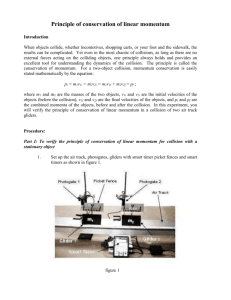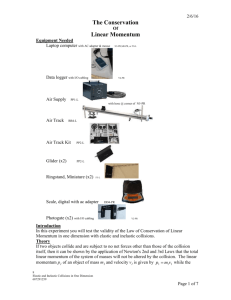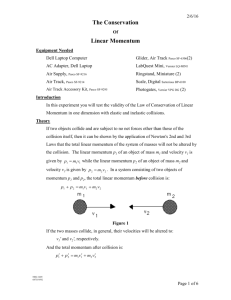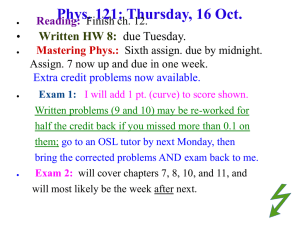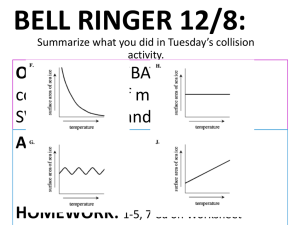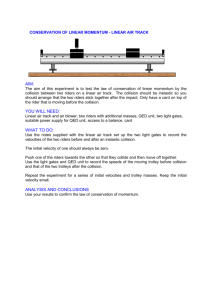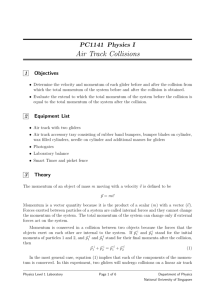The Simple Pendulum
advertisement
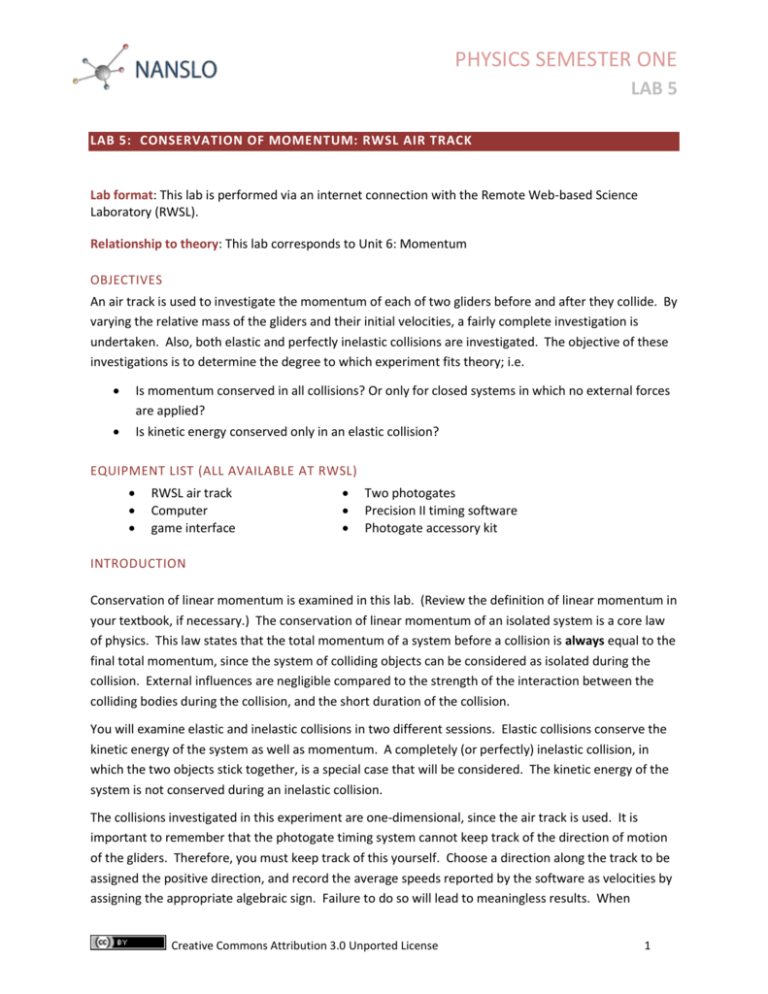
PHYSICS SEMESTER ONE LAB 5 LAB 5: CONSERVATION OF MOMENTUM: RWSL AIR TRACK Lab format: This lab is performed via an internet connection with the Remote Web-based Science Laboratory (RWSL). Relationship to theory: This lab corresponds to Unit 6: Momentum OBJECTIVES An air track is used to investigate the momentum of each of two gliders before and after they collide. By varying the relative mass of the gliders and their initial velocities, a fairly complete investigation is undertaken. Also, both elastic and perfectly inelastic collisions are investigated. The objective of these investigations is to determine the degree to which experiment fits theory; i.e. Is momentum conserved in all collisions? Or only for closed systems in which no external forces are applied? Is kinetic energy conserved only in an elastic collision? EQUIPMENT LIST (ALL AVAILABLE AT RWSL) RWSL air track Computer game interface Two photogates Precision II timing software Photogate accessory kit INTRODUCTION Conservation of linear momentum is examined in this lab. (Review the definition of linear momentum in your textbook, if necessary.) The conservation of linear momentum of an isolated system is a core law of physics. This law states that the total momentum of a system before a collision is always equal to the final total momentum, since the system of colliding objects can be considered as isolated during the collision. External influences are negligible compared to the strength of the interaction between the colliding bodies during the collision, and the short duration of the collision. You will examine elastic and inelastic collisions in two different sessions. Elastic collisions conserve the kinetic energy of the system as well as momentum. A completely (or perfectly) inelastic collision, in which the two objects stick together, is a special case that will be considered. The kinetic energy of the system is not conserved during an inelastic collision. The collisions investigated in this experiment are one-dimensional, since the air track is used. It is important to remember that the photogate timing system cannot keep track of the direction of motion of the gliders. Therefore, you must keep track of this yourself. Choose a direction along the track to be assigned the positive direction, and record the average speeds reported by the software as velocities by assigning the appropriate algebraic sign. Failure to do so will lead to meaningless results. When Creative Commons Attribution 3.0 Unported License 1 PHYSICS SEMESTER ONE LAB 5 analyzing your data, remember also that the timing software calculates the average speed, not the instantaneous speed. PROCEDURE This is a two part experiment due to the fact that the gliders must be prepared for either elastic collisions or inelastic collisions before the lab. You must perform the elastic and inelastic collision experiments in two separate sessions. We will be using two gliders in each run of this experiment. Some of the experiments will require one glider to be placed in the centre of the air track with the manipulator arm. The centre glider should be at rest. The “level” track will probably not be perfectly level so it is important to launch the other glider soon after the centre glider is placed (before it starts moving too quickly). Other experiments will have both gliders moving towards each other, launched from opposite ends of the air track. The gliders can be placed on the track with the manipulator arm. The track can be tilted one way to move both gliders to one end of the track. Select the appropriate Hold command to hold the glider closest to that end. Tilt the track the other way and select the other Hold command to hold the second glider. Set the gliders’ solenoid launch settings. You can select the Launch Both, or the LaunchDelay commands if you wish to delay one of the launches for timing purposes. Part a: Elastic Collisions Two gliders of the same or of different mass will collide and bounce off each other. The average velocities of the gliders before and after the collision will be determined, and the momentum will be computed from these. Make sure the track is as close to level as possible by aligning the laser with the level target. If the track is not level, the gliders will accelerate. After a collision, a glider may be moving slowly. The acceleration due to lack of level may then cause a change in velocity that is comparable to the actual velocity of the slow-moving glider. This can give rise to a very large fractional error, since we are assuming that the system is isolated. You can also try to adjust the launch conditions so the final velocities are not too small to minimize this error. This is NOT an invitation to hurtle the gliders along the track. After levelling the track at the start, select the Store Level command. This stores the position of the linear actuator controlling the track level which allows you to use the Re-Level command to return the track to level for future runs. 1. When using the Re-level command, is it possible to introduce error from slop in the threads? Explain. Measure the mass of each glider so you can compute the momentum. Make sure you clearly identify which glider has which mass, and don’t mix up the assignment. Creative Commons Attribution 3.0 Unported License 2 PHYSICS SEMESTER ONE LAB 5 Measure the length of the timing flags. You will need to enter these values for the software to calculate the speeds of the gliders. You will measure the velocity of each glider both before and after the collision, not during. This can be achieved by having the collisions occur between the two photogates. This may take some practice with the launch controls. You will be using the Collision Timing mode. This mode keeps track of each gate separately. Try a practice run with one glider initially stationary between the gates. Watch the photogate times as the gliders pass through the gates. Note how the software reports the data and devise a way to record the data in as clear a manner as possible in your report. Remember to keep track of directions! Remember that you need to measure the momentum of each glider before and after the collision. Therefore, if both gliders are moving after the collision, allow them to completely pass through the gates before removing them from the track. 2. If both gliders pass through the same photogate after the collision, how does the computer report the data? Make sure you understand the results that the computer provides. Investigate the following elastic collisions: Equal or nearly equal mass, one glider initially at rest. Unequal mass, one glider initially at rest. Repeat the above two collisions with nonzero initial speed for both gliders. Part b: Inelastic Collisions (separate RWSL session) The elastic collision gliders are replaced with collisions that will undergo nearly perfect inelastic collisions. Each glider has a small piece of Velcro on it so the gliders stay together after the collision. The two gliders will be moving as a single unit after the collision so there will be a single final velocity. Repeat the collisions from section 1 (e.g. motionless target, target more massive than moving glider, etc.) 3. Where is the energy lost in an inelastic collision? ANALYSIS Deduce whether your results in parts I and II are consistent with conservation of momentum. At times heat is generated in collisions, and the sum of potential and kinetic energies is not the same before and after the collision. Choose a couple of sets of your data and compute the total kinetic Creative Commons Attribution 3.0 Unported License 3 PHYSICS SEMESTER ONE LAB 5 energies before and after (a) an elastic collision and (b) a totally inelastic collision. Perform a comparison and determine if your results are consistent with the predictions of the theory. QUESTIONS Complete all numbered questions throughout this lab and be sure to include your answers along with your experimental data and results. Don’t forget to analyze all sources of error, compute the error in each case and include these in your report. REFERENCES This lab is adapted from Reference 1: 1. Laboratory Manual for PHY 100 & 101 Introductory Physics I and II and PHY 120 & 121 Principles of Physics I and II, 5th Edition 2004, prepared by Jason Diemer, North Island College NANSLO Physics Core Units and Laboratory Experiments by the North American Network of Science Labs Online, a collaboration between WICHE, CCCS, and BCcampus is licensed under a Creative Commons Attribution 3.0 Unported License; based on a work at rwsl.nic.bc.ca. Funded by a grant from EDUCAUSE through the Next Generation Learning Challenges. Creative Commons Attribution 3.0 Unported License 4
